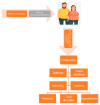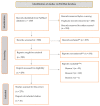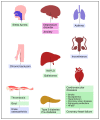Metabolic Disorders, the Microbiome as an Endocrine Organ, and Their Relations with Obesity: A Literature Review
- PMID: 38003917
- PMCID: PMC10672252
- DOI: 10.3390/jpm13111602
Metabolic Disorders, the Microbiome as an Endocrine Organ, and Their Relations with Obesity: A Literature Review
Abstract
The etiology of metabolic disorders, such as obesity, has been predominantly associated with the gut microbiota, which is acknowledged as an endocrine organ that plays a crucial role in modulating energy homeostasis and host immune responses. The presence of dysbiosis has the potential to impact the functioning of the intestinal barrier and the gut-associated lymphoid tissues by allowing the transit of bacterial structural components, such as lipopolysaccharides. This, in turn, may trigger inflammatory pathways and potentially lead to the onset of insulin resistance. Moreover, intestinal dysbiosis has the potential to modify the production of gastrointestinal peptides that are linked to the feeling of fullness, hence potentially leading to an increase in food consumption. In this literature review, we discuss current developments, such as the impact of the microbiota on lipid metabolism as well as the processes by which its changes led to the development of metabolic disorders. Several methods have been developed that could be used to modify the gut microbiota and undo metabolic abnormalities.
Methods: After researching different databases, we examined the PubMed collection of articles and conducted a literature review.
Results: After applying our exclusion and inclusion criteria, the initial search yielded 1345 articles. We further used various filters to narrow down our titles analysis and, to be specific to our study, selected the final ten studies, the results of which are included in the Results section.
Conclusions: Through gut barrier integrity, insulin resistance, and other influencing factors, the gut microbiota impacts the host's metabolism and obesity. Although the area of the gut microbiota and its relationship to obesity is still in its initial stages of research, it offers great promise for developing new therapeutic targets that may help prevent and cure obesity by restoring the gut microbiota to a healthy condition.
Keywords: metabolic disorders; microbiota; obesity.
Conflict of interest statement
The authors declare no conflict of interest.
Figures







References
-
- World Health Organisation. (n.d.). Retrieved 5 July 2023. [(accessed on 6 July 2023)]. Available online: https://www.who.int/news-room/fact-sheets/detail/obesity-and-overweight.
-
- World Health Organisation. (n.d.). Retrieved 5 July 2023. [(accessed on 10 July 2023)]. Available online: https://www.who.int/tools/growth-reference-data-for-5to19-years/indicato....
Publication types
LinkOut - more resources
Full Text Sources

